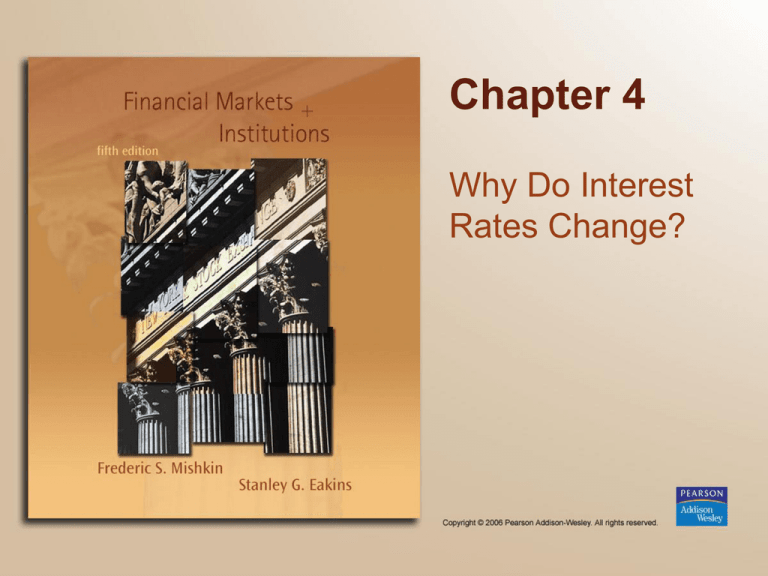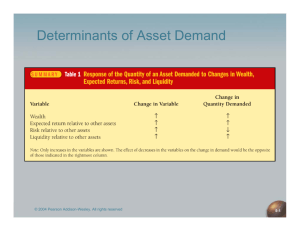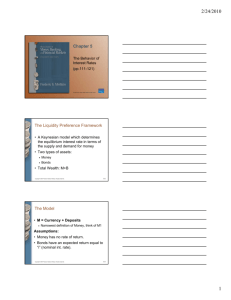
Chapter 4
Why Do Interest
Rates Change?
Chapter Preview
• Although interest rates in the U.S. have
been relatively stable in recent history, this
has not always been the case. We
examine the forces the move interest rates
and the theories behind those movements.
Topics include:
– Determining Asset Demand
– Supply and Demand in the Bond Market
– Changes in Equilibrium Interest Rates
Copyright © 2006 Pearson Addison-Wesley. All rights reserved.
4-2
Determinants of Asset Demand
• An asset is a piece of property that is a store of value.
Facing the question of whether to buy and hold an asset
or whether to buy one asset rather than another, an
individual must consider the following factors:
1. Wealth, the total resources owned by the individual, including
all assets
2. Expected return (the return expected over the next period) on
one asset relative to alternative assets
3. Risk (the degree of uncertainty associated with the return) on
one asset relative to alternative assets
4. Liquidity (the ease and speed with which an asset can be
turned into cash) relative to alternative assets
Copyright © 2006 Pearson Addison-Wesley. All rights reserved.
4-3
EXAMPLE 1: Expected Return
What is the expected return on the Mobil Oil bond if the return
is 12% two-thirds of the time and 8% one-third of the time?
Solution
The expected return is 10.68%.
R e = p1 R 1 + p2 R 2
where
p1 = probability of occurrence of return 1 = 2/3
=
.67
R1 = return in state 1
= 12% = 0.12
p2 = probability of occurrence return 2
= 1/3
=
R2 = return in state 2
= 8%
= 0.08
.33
Thus
Re = (.67)(0.12) + (.33)(0.08) = 0.1068 = 10.68%
Copyright © 2006 Pearson Addison-Wesley. All rights reserved.
4-4
EXAMPLE 2: Standard Deviation (a)
• What is the standard deviation of the
returns on the Fly-by-Night Airlines stock
and Feet-on-the Ground Bus Company?
Of these two stocks, which is riskier?
* FbNA ~ 15% or 5% return, with 50/50 probability
* FotGBC ~ 10% return, with 100% probability
Copyright © 2006 Pearson Addison-Wesley. All rights reserved.
4-5
EXAMPLE 2: Standard Deviation (b)
• Solution
– Fly-by-Night Airlines has a standard deviation of returns of 5%.
Copyright © 2006 Pearson Addison-Wesley. All rights reserved.
4-6
EXAMPLE 2: Standard Deviation (c)
• Feet-on-the-Ground Bus Company has a
standard deviation of returns of 0%.
Copyright © 2006 Pearson Addison-Wesley. All rights reserved.
4-7
EXAMPLE 2: Standard Deviation (d)
• Fly-by-Night Airlines has a standard deviation of returns of
5%; Feet-on-the-Ground Bus Company has a standard
deviation of returns of 0%
• Clearly, Fly-by-Night Airlines is a riskier stock because its
standard deviation of returns of 5% is higher than the zero
standard deviation of returns for Feet-on-the-Ground Bus
Company, which has a certain return
• A risk-averse person prefers stock in the Feet-on-theGround (the sure thing) to Fly-by-Night stock (the riskier
asset), even though the stocks have the same expected
return, 10%. By contrast, a person who prefers risk is a
risk preferrer or risk lover. Most people are risk-averse,
especially in their financial decisions
Copyright © 2006 Pearson Addison-Wesley. All rights reserved.
4-8
Determinants of Asset Demand (2)
• The quantity demanded of an asset differs by factor.
1. Wealth: Holding everything else constant, an increase in wealth
raises the quantity demanded of an asset
2. Expected return: An increase in an asset’s expected return
relative to that of an alternative asset, holding everything else
unchanged, raises the quantity demanded of the asset
3. Risk: Holding everything else constant, if an asset’s risk rises
relative to that of alternative assets, its quantity demanded
will fall
4. Liquidity: The more liquid an asset is relative to alternative
assets, holding everything else unchanged, the more desirable
it is, and the greater will be the quantity demanded
Copyright © 2006 Pearson Addison-Wesley. All rights reserved.
4-9
Determinants of Asset Demand (3)
Copyright © 2006 Pearson Addison-Wesley. All rights reserved.
4-10
Derivation of Demand Curve
iR
e
F P
P
Point A
P $950
i
$1000 $950
$950
.053 5.3%
Bd 100
Point B
P $900
i
$1000 $900
$900
.111 11.1%
Bd 200
Copyright © 2006 Pearson Addison-Wesley. All rights reserved.
4-11
Derivation of Demand Curve
• Point C:P = $850 i = 17.6% Bd = 300
• Point D: P = $800 i = 25.0% Bd = 400
• Point E: P = $750 i = 33.0% Bd = 500
• Demand Curve is Bd in Figure 1 which
connects points A, B, C, D, E.
– Has usual downward slope
Copyright © 2006 Pearson Addison-Wesley. All rights reserved.
4-12
Supply and Demand Analysis
of the Bond Market
Figure 4.1 Supply and Demand for Bonds
Copyright © 2006 Pearson Addison-Wesley. All rights reserved.
4-13
Derivation of Supply Curve
• Point F: P = $750 i = 33.0% Bs = 100
• Point G:P = $800 i = 25.0% Bs = 200
• Point C: P = $850 i = 17.6% Bs = 300
• Point H: P = $900 i = 11.1% Bs = 400
• Point I: P = $950 i = 5.3% Bs = 500
• Supply Curve is Bs that connects points F,
G, C, H, I, and has upward slope
Copyright © 2006 Pearson Addison-Wesley. All rights reserved.
4-14
Market Equilibrium
1. Occurs when Bd = Bs, at P* = 850, i* = 17.6%
2. When P = $950, i = 5.3%, Bs > Bd
(excess supply): P to P*, i to i*
3. When P = $750, i = 33.0, Bd > Bs
(excess demand): P to P*, i to i*
Copyright © 2006 Pearson Addison-Wesley. All rights reserved.
4-15
Market Demand Conditions
Market equilibrium occurs when the amount that people
are willing to buy (demand) equals the amount that people
are willing to sell (supply) at a given price
Excess supply occurs when the amount that people are
willing to sell (supply) is greater than the amount people are
willing to buy (demand) at a given price
Excess demand occurs when the amount that people are
willing to buy (demand) is greater than the amount that
people are willing to sell (supply) at a given price
Copyright © 2006 Pearson Addison-Wesley. All rights reserved.
4-16
Loanable Funds Terminology
1. Demand for
bonds = supply of
loanable funds
2. Supply of
bonds = demand for
loanable funds
Figure 4.2 A Comparison of Terminology: Loanable
Funds and Supply and Demand for Bonds
Copyright © 2006 Pearson Addison-Wesley. All rights reserved.
4-17
Shifts in the Demand Curve
Figure 4.3 Shifts in the Demand Curve for Bonds
Copyright © 2006 Pearson Addison-Wesley. All rights reserved.
4-18
How Factors Shift the Demand Curve
1. Wealth
–
Economy , wealth , Bd , Bd shifts out to
right
2. Expected Return
–
–
i in future, Re for long-term bonds , Bd
shifts out to right
πe , relative Re , Bd shifts out to right
Copyright © 2006 Pearson Addison-Wesley. All rights reserved.
4-19
How Factors Shift the Demand Curve
3. Risk
–
–
Risk of bonds , Bd , Bd shifts out to right
Risk of other assets , Bd , Bd shifts out to
right
4. Liquidity
–
–
Liquidity of bonds , Bd , Bd shifts out to
right
Liquidity of other assets , Bd ,Bd shifts out
to right
Copyright © 2006 Pearson Addison-Wesley. All rights reserved.
4-20
Factors
That Shift
Demand
Curve
Summary of Shifts
in the Demand for Bonds
1. Wealth: in a business cycle expansion with
growing wealth, the demand for bonds rises,
conversely, in a recession, when income and
wealth are falling, the demand for bonds falls
2. Expected returns: higher expected interest
rates in the future decrease the demand for
long-term bonds, conversely, lower expected
interest rates in the future increase the demand
for long-term bonds
Copyright © 2006 Pearson Addison-Wesley. All rights reserved.
4-22
Summary of Shifts
in the Demand for Bonds (2)
3. Risk: an increase in the riskiness of bonds
causes the demand for bonds to fall, conversely,
an increase in the riskiness of alternative assets
(like stocks) causes the demand for bonds
to rise
4. Liquidity: increased liquidity of the bond market
results in an increased demand for bonds,
conversely, increased liquidity of alternative
asset markets (like the stock market) lowers the
demand for bonds
Copyright © 2006 Pearson Addison-Wesley. All rights reserved.
4-23
Shifts in the Supply Curve
1.
Profitability
of Investment
Opportunities
–
2.
Business cycle expansion,
investment opportunities
, Bs , Bs shifts out to
right
Expected Inflation
–
3.
πe , Bs , Bs shifts out
to right
Government Activities
–
Deficits , Bs , Bs shifts
out to right
Figure 4.4 Shift in the Supply Curve for Bonds
Copyright © 2006 Pearson Addison-Wesley. All rights reserved.
4-24
Factors That Shift Supply Curve
Copyright © 2006 Pearson Addison-Wesley. All rights reserved.
4-25
Summary of Shifts
in the Supply of Bonds
1.
Expected Profitability of Investment Opportunities:
in a business cycle expansion, the supply of bonds
increases, conversely, in a recession, when there are
far fewer expected profitable investment opportunities,
the supply of bonds falls
2.
Expected Inflation: an increase in expected inflation
causes the supply of bonds to increase
3.
Government Activities: higher government deficits
increase the supply of bonds, conversely, government
surpluses decrease the supply of bonds
Copyright © 2006 Pearson Addison-Wesley. All rights reserved.
4-26
Changes in πe: The Fisher Effect
• If πe
1. Relative Re ,
Bd shifts in
to left
2. Bs , Bs shifts
out to right
3. P , i
Figure 4.5 Response to a Change in Expected Inflation
Copyright © 2006 Pearson Addison-Wesley. All rights reserved.
4-27
Evidence on the Fisher Effect
in the United States
Figure 4.6 Expected Inflation and Interest Rates (Three-Month Treasury Bills), 1953–2004
Copyright © 2006 Pearson Addison-Wesley. All rights reserved.
4-28
Summary of the Fisher Effect
1.
If expected inflation rises from 5% to 10%, the expected
return on bonds relative to real assets falls and, as a
result, the demand for bonds falls
2.
The rise in expected inflation also means that the real
cost of borrowing has declined, causing the quantity of
bonds supplied to increase
3.
When the demand for bonds falls and the quantity of
bonds supplied increases, the equilibrium bond
price falls
4.
Since the bond price is negatively related to the interest
rate, this means that the interest rate will rise
Copyright © 2006 Pearson Addison-Wesley. All rights reserved.
4-29
Business Cycle Expansion
1. Wealth , Bd , Bd
shifts out to right
2. Investment , Bs
, Bs shifts right
3. If Bs shifts more
than Bd then P ,
i
Figure 4.7 Response to a Business Cycle Expansion
Copyright © 2006 Pearson Addison-Wesley. All rights reserved.
4-30
Evidence on Business Cycles
and Interest Rates
Figure 4.8 Business Cycle and Interest Rates (Three-Month Treasury Bills), 1951–2004
Copyright © 2006 Pearson Addison-Wesley. All rights reserved.
4-31
Profiting from Interest-Rate
Forecasts
• Methods for forecasting
1. Supply and demand for bonds: use Flow of
Funds Accounts
and judgment
2. Econometric Models: large in scale, use
interlocking equations that assume past
financial relationships will hold in the future
Copyright © 2006 Pearson Addison-Wesley. All rights reserved.
4-32
Profiting from Interest-Rate
Forecasts (cont.)
• Make decisions about assets to hold
1. Forecast i , buy long bonds
2. Forecast i , buy short bonds
• Make decisions about how to borrow
1. Forecast i , borrow short
2. Forecast i , borrow long
Copyright © 2006 Pearson Addison-Wesley. All rights reserved.
4-33
Web
Appendix
Applying the Asset
Market Approach
to a Commodity
Market: The Case
of Gold
Supply and Demand in Gold Market
• Deriving Demand Curve
P Pt
e
R
g
Pt
e
e
t 1
– Pet+1 is held constant
– Pt , ge , Re Gd
– Demand curve is downward sloping
• Deriving Supply Curve
– Pt , more production, Gs
– Supply curve is upward sloping
Copyright © 2006 Pearson Addison-Wesley. All rights reserved.
4-35
Supply and Demand in Gold Market
• Market Equilibrium
1. Gd = Gs
2. If Pt > P* = P1, Gs > Gd, Pt to P*
3. If Pt < P* = P1, Gs < Gd, Pt to P*
Copyright © 2006 Pearson Addison-Wesley. All rights reserved.
4-36
Changes in Equilibrium
• Factors That Shift Demand Curve for Gold
1. Wealth
2. Expected return on gold relative to alternative assets
3. Riskiness of gold relative to alternative assets
4. Liquidity of gold relative to alternative assets
• Factors That Shift Supply Curve for Gold
1. Technology of mining
2. Government sales of gold
Copyright © 2006 Pearson Addison-Wesley. All rights reserved.
4-37
Response of Gold Market to a
Change in πe
• If πe
1. πe , Pet+1 ; at given Pt,
ge Gd Gd shifts
right
2. Go to point 2; Pt
3. Price of gold positively
related to πe
4. Gold price is barometer
of π- pressure
Figure 4.Web A1 A Change in the Equilibrium Price of Gold
Copyright © 2006 Pearson Addison-Wesley. All rights reserved.
4-38
Chapter Summary
• Determining Asset Demand: We examined
the forces that affect the demand and
supply of assets.
• Supply and Demand in the Bond Market:
We examine those forces in the context of
bonds, and examined the impact on
interest rates.
Copyright © 2006 Pearson Addison-Wesley. All rights reserved.
4-39
Chapter Summary (cont.)
• Changes in Equilibrium Interest Rates: We
further examined the dynamics of changes
in supply and demand in the bond market,
and the corresponding effect on bond
prices and interest rates.
Copyright © 2006 Pearson Addison-Wesley. All rights reserved.
4-40









